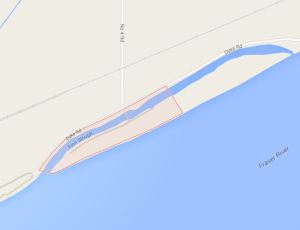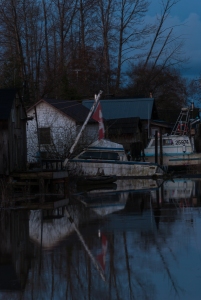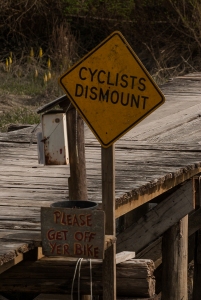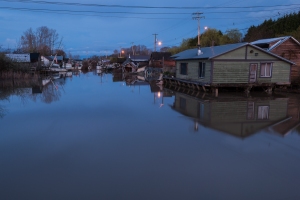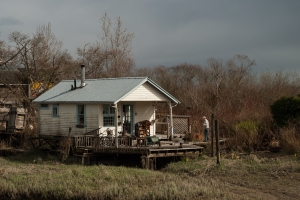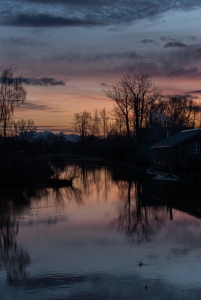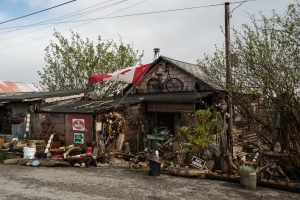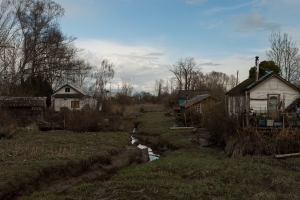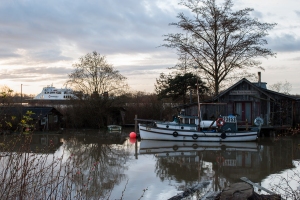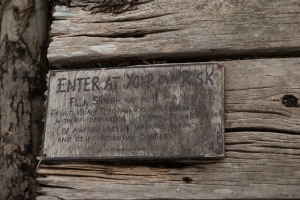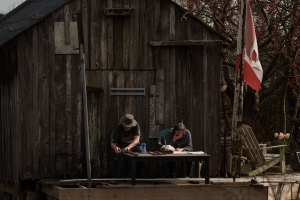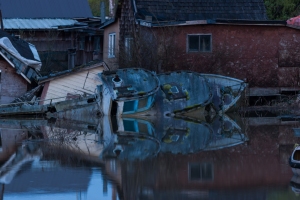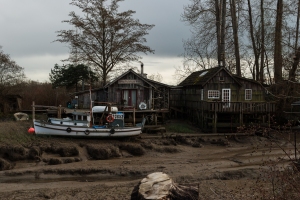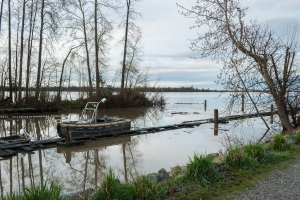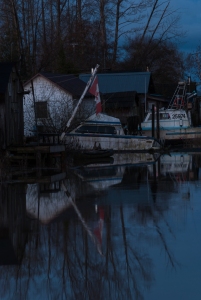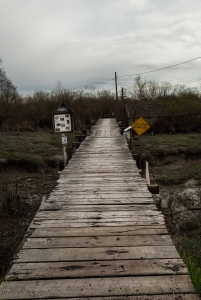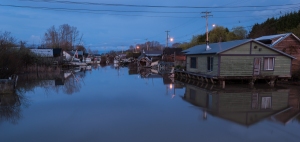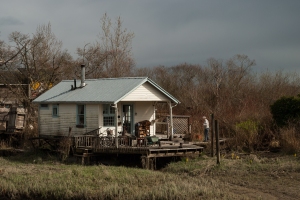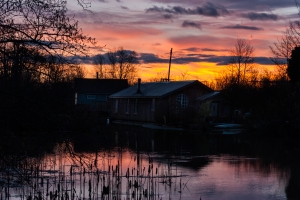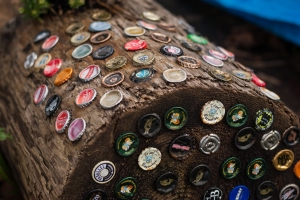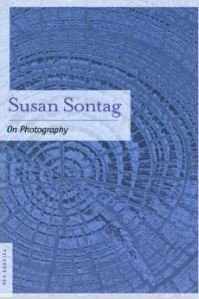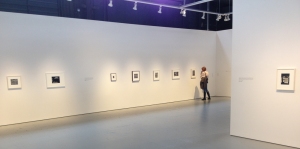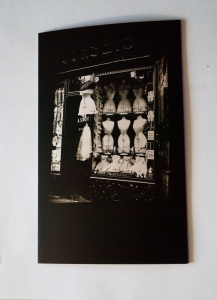I awaited my tutor feedback for Assignment 5 with bated breath, hoping it would come in time for me to get my submissions ready for assessment. It arrived this afternoon. I have added my comments in italics.
Overall Comments
My tutor stated that this was my most mature and interesting assignment to date. It showed my technical and visual development over the course and showed my potential as a degree student and a professional photographer. He found the subject of Finn Slough both fascinating and strange, the proximity to the water is palpable in my photos and was the visual key to the project as a whole.
[Thank you. I had really enjoyed working on this project and found that I ‘found my groove’ with it.]
However he stated that there was one major flaw with the project and wanted to know where the community was in this series about a community. He assumed that it was the immigrant community that attracted me to Finn Slough and mentioned that presumably the descendants of the original Finns and ex-Soviet states were still living in the slough. He said it would have been a wonderful opportunity to look into a micro-world that has managed to remain aloof from our globalized society and see how their culture has survived, developed and cross-fertilized with Canadian life.
[While I get where he is coming from, in that I did not get close up portraits of any of the people living in this community, they do feature in two of my photographs. According to the research I have done very few descendants from the original families still live in the slough. I think there are two at most. While some still fish, it is now mainly an artists community now.]
The other obvious criticism is the lack of a clear narrative. This is a series, and it is a good series, but there is a difference between similar kinds of photo repeated and a developing story where something changes, grows, time passes. The narrative that is suggested to me is connected to the tide rather than the light. You have images here of very high tide and one of low tide. This dramatically transforms the landscape, turning a water-logged land into a land of muddy channels.
[There were two photos that had the same subject, namely the historical boat, Eva which show the location both at high tide and low tide. My narrative was always meant to be about the tides rather than the light, although shooting at different times, days and during different weather conditions would definitely have changed the light. I believe some of these lighting conditions served to enhance the images, rather than detract from them. Actually there are six images taken at high tide and four images taken at low tide. The images where the subjects are surrounded by grass (no 2, 4, 7) are all low tide images. This is a wetland area and vegetation grows below the water, grass, bulrushes, skunk cabbages and so on. Perhaps my captions lacked this explanation.]
My tutor went on to say that the work is promising and that I should continue with my studies. He further suggested that this project could develop into a larger body of work that would include the missing elements he has mentioned.
Feedback on images
Cover
My tutor suggested that the photo was not sharp, that it look as if it had been blown up.
[The photo was not blown up, but he may have been picking up on the blur on the flag. It was a long exposure taken just before dawn and there was a breeze blowing. However I have another photo of the same scene which was taken during a lull in the breeze which I will substitute].
2
This was not an interesting image according to my tutor. He said I needed to figure out how to give it more depth of meaning visually.
[I have another photo of the bridge which I will substitute].
3
This is an atmospheric water-scape giving the best overview of the living conditions in this place with the houses on stilts. You’ve maybe got a little too much of the empty water, but it’s still a strong shot.
[I have to agree on the empty water. I had cropped it, but found that I was losing too much detail on the left bank. I shall try a panorama crop].
4
The house is another wonderful photo, plenty of telling detail here in really lovely light. Where has the water gone? Should you have included it in the frame to retain the watery theme?
[Thank you. I agree the light was fantastic at that time. Where has the water gone? It is low tide, so the water has gone out to sea. During low time Finn Slough is totally emptied of water].
5
It’s good to see the mountains in the distance. This maybe a little too pretty and disconnected to form part of the series, where is Finn Slough here? This could be anywhere. You could try lifting the houses out of the dark more. (Note that this may be a monitor issue).
[I can see your point that it may look too pretty for the series, so I will substitute another photo that I took of the same house at a slightly different angle].
6
This house looks so full of character that it makes me want to meet the people who live here. It looks like something designed by a set designer, but it’s real and it’s organic. It is also interesting to see the Canadian flag flying, which could say something of the need to defend oneself from xenophobia.
I think this shot would have been improved if you had placed the inhabitants in front of it, on the road, closer to camera. This would have created a relationship: house + the people who live there.
[I agree with the point about the house. It is laden with character. Personally I think the xenophobia bit might be stretching it a bit. Canada is one of the few multicultural countries in the world where multiculture is actually working. Canadians are a patriotic people and like their American counterparts, they love to fly their flag from their houses. Many immigrants have also taken to flying their homeland’s flag outside their houses and apartments as well. I totally concur that this image would have been raised to a different level if I had been able to photograph the inhabitant. I did speak to her on several occasions and asked if I could take her photo, but she refused and I have to respect her wishes].
7
It’s wonderful to see the connection between these houses and the landscape, there is not an assault on the land here, but a true dwelling in it. Sisu is an interesting word here because this place would sure require a lot of it!
8
There is a contrast here, but it is not that clearly visualized by this shot because the Seaspan ferry is obscured by trees. Good that you noticed it though.
[What most attracted me to this image were the various layers from front to back: the foreground water, the row of houses, the row of vegetation behind them, the Fraser River with the ferry passing by and beyond that another island and of course the sky].
9
Another sign, which I think you can cut out of the series.
[I rather like the sign which is on the old drawbridge. I find it rather ironic that a bridge that was built in the 1940’s would have a sign on it that features a website URL. As this was one of my details shots, I will substitute it for another].
10
This was an opportunity to get a lot closer. This couple are evidently engrossed in their work and their heads are down. That can work if their work is illustrated by their body postures in a strong way. But here, it is unclear. A formal portrait using the wooden shack as a background would have presented more visual interest.
[Yes, it would have been nicer to be able to get closer, but it was high tide and they were across the river. I was as close as I could get].
11
The Mermaid is a remarkable shot with beautiful light and colour. It could well be the cover shot because it works almost as an optical illusion with oddly placed planes – like a Cubist painting. It’s bizarre. Well spotted and well framed.
[This image has grown on me. At first I didn’t like it, but after having lived with it in my office for a few weeks, I have come to appreciate the intricacies of it. If held in portrait format it looks like an abstract of a totem pole].
12
This is a much more satisfying shot of the Eva in front of the old house, though I think you will need to choose either one or the other because this looks like repetition. The light, tones and colours are really beautiful and it’s interesting that we see the dry river bed at low tide here for the first time.
[I agree that there is repetition. I was worried about that. I desperately wanted to depict high tide and low tide and aesthetically speaking the Eva was the best choice that was accessible. This was also the only location where I could get a “pure mud” shot as just past this the river bed is covered by vegetation].
13
The old “taken from the road shot”! It does appear a little lazy when the road appears as a diagonal at the bottom of the frame. Apart from that it’s a shot that could work, showing the tall thin trees and the little islands and spits.
[Actually the shot was taken from the dyke wall. As this is both the entrance and exit for the boats of Finn Slough I do think it is a good closer].
Learning Logs/Critical essays
The blog and your research are looking good. A bit more studying will give you the terms you lack in explaining photographs.
The accompanying text does show some immaturity (unlike the images) because it doesn’t really add much other than anecdotal information.
[I’m not sure I completely understand this statement. The brief stated that we should just write captions, which according to the Oxford Dictionary means “words printed with an illustration or photograph in order to describe or explain it.”]
I like the way Virginia has decorated her house with flotsam and jetsam, but Virginia is missing from the shot so the text tries to ‘stand in’ for the missing person.
[I have already explained Virginia’s absence above and in my assignment. She did not want to be photographed].
The historical information is interesting as an opening but it does tend to look somewhat incongruous when we see that it is essentially a landscape series. Such a text would then focus more on the nature of landscape.
[Point taken, but I do feel that the history is rather necessary to understand the landscape too].
Your visual skills are getting stronger and there are photos here that could turn up in National Geographic or some such magazine. You are noticing the light, the colour and the texture of things and ordering shapes in the frame really well.
[Thank you! That is very encouraging to hear].
Suggested reading/viewing
I see you’re reading Sontag’s ‘On Photography’, which can be difficult. Try David Bate’s ‘Photography: Key Concepts’.
[I had noted in my review on Sontag’s ‘On Photography’ that I had read it through once. I purchased Photography: Key Concepts after the tutor’s same recommendation in Assignment 4 Tutor Feedback].

